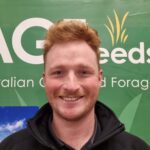Clover and Medic seeds are both members of the legume family. Clover, which encompasses various species like red clover and white clover, is valued for its ability to fix nitrogen in the soil, enriching the soil, and enhancing crop growth.
Medic plays a vital role in sustainable farming systems as cover crops, erosion control plants, and sources of high-protein forage.
A self-regenerating annual that gets its name from its ability to bury its seed. Native to the Mediterranean region, sub clovers grow on a wide range of soil types and varying rainfall, from 250mm to in excess of 750mm. Sub clovers are divided into three main subspecies, with large variations.
These black-seeded varieties can tolerate a wide range of acid soils, mostly well drained.
Seed count: 133,000 – 250,000/kg Sowing rate: 4-8kg/Ha
500-700mm
Campeda is a black seeded sub clover that demonstrates a prostrate to semi erect growth habit and persists well on various soil types. It has mid season maturity which makes it adaptable to medium and high rainfall environments
500-700mm
RLEM Tolerant
A vigorous mid-late season cultivar. It is best suited to well-drained, moderately acid soils in areas where the growing season extends to mid-November. Emerging seedlings suffer less damage from red-legged earth mite than older subterraneum clovers
650mm+
RLEM Tolerant
Developed as a replacement for cv. Denmark with improved cotyledon tolerance to red legged earth mite (RLEM). Suited to well drained, moderately acid soils in areas of southern Australia where the growing season extends to mid-late November.
The varieties of this sub-species are adapted to acid soils subject to winter water logging, but also perform well in well drained soils.
Seed count: 90,000 – 120,000/kg Sowing rate: 6-10kg/Ha
450mm+
Cost Effective
Early mid-season alternative for Trikkala. Riverina provides greater autumn and winter production, with a good level of hard seed. It provides high resistance to all three strains of Phytophthora root rot.
450mm+
High Yielding
A mid-season sub-clover. It is well adapted to moderately acidic soils prone to waterlogging and to loamy and clay soils with good water retention. Its upright, vigorous growth makes it suited to hay and silage production, as well as to grazing by cattle or sheep.
550mm+
High Yielding
Rouse is a mid to late-season cultivar. Excellent overall forage yield with very high seed yield leading to improved seedling regeneration over comparative cultivars.
Purplish-black seeded variety best suited for neutral to alkaline soils.
Seed count: 77,000 – 140,000/kg Sowing rate: 8-12kg/Ha
500-750mm+
Cropping Rotation
Black seeded brachy sub clover Antas demonstrates a prostrate to semi erect growth habit and persists well on various soil types. It has mid to late season maturity and is suited to medium to high rainfall environments.
Provides high dry matter production which makes it very adaptable across pasture and cropping systems
Originally introduced from Turkey, it is a hard seeded self-regenerating annual that is capable of producing an abundance of seed that can quite often find its way into a system via hay. Will tolerate very heavy water logged soils and soils of moderate salinity, with a pH from acid to alkaline.
Rainfall: 400mm – 700mm
Seed Count: 1,400,000/kg approx
Sowing Rate: 1-3kg/Ha in mixes, 3-5kg/Ha pure stands
450mm+
Tolerates relatively severe waterlogging. High levels of hard seed. Good growth during late Winter and Spring. Good hay production.
550mm+
High performance variety with good tolerance of waterlogging and moderate tolerance of salinity. Later maturing than Paradana, with excellent late spring production. Ideal for grazing or hay/silage.
An annual clover native to the Middle East, tolerates a range of soil conditions including wet, slightly salty and slightly acid to alkaline. If sown in early autumn can be quite productive in winter, with a high level of spring growth. Persian clovers are divided into two main subspecies. Sub-species majus will grow well into summer under irrigation, producing high quality forage.
Rainfall: 350mm min and higher or irrigation (depends on cultivar chosen)
Seed count: 800,000/kg (majus), 1,400,000/kg (resuptinatum)
Sowing rate: 2-4kg/Ha Mixes, 4-5kg/Ha Dryland, 6-8kg/Ha High Rainfall or Irrigation
500mm+
Late
Soft Seeded
Sub species Majus characterised by being nearly 100% soft seeded, therefore needs to be re-sown each year, majus are of very high nutritive value.
Enrich is a one-year forage crop. Soft seeded, erect plant with thick fleshy hollow stems and late season maturity. Tolerates various soil types, waterlogging and mild salinity.
350mm+
Quick
Hard Seeded
Sub-Species Resupinatum has very high levels of hard seed and,if let go to seed, is a self regenerating annual.
Prolific is a very early season, hard seeded cultivar for dryer areas. Prolific is suited to a range of soils, tolerates heavy soils, waterlogging, and mild salinity. Can be used in rotation with crops in low rainfall cropping zones or in perennial pasture mixes.
450mm+
Very Late
High Hard Seed
Originated from the Mediterranean region. Suited to well-drained soils, slightly acid to slightly alkaline. A self-regenerating annual clover with thick hollow stems, being an aerial seeder it owes its self-regeneration to its high level of hard seed. Commonly provides late spring/early summer growth. Erect growth habit is ideal for cattle, as it is not known to cause bloat.
Seed Count: 880,000/kg
Sowing Rate: 2-8kg/Ha mixes, 10-15kg/ pure stands
450mm+
Wide Adaptation
Pollinator
A native to southern Europe, a soft seeded annual clover that is very quick to establish. Very useful autumn and winter growth because of its flush in early spring. A worthwhile addition for silage crops. Suited to a wide range of soil types, from sandy to heavy textured, and soils of very low to neutral pH. It has a very distinctive brilliant red flower.
Seed Count: 250,000 – 280,000/kg
Sowing Rate: 1-4kg/Ha mixes, 8-10kg/ pure stand
Quick
Water Logging Tolerant
Salt Tolerant
Messina (Melilotus siculus) is an aerial-seeding annual legume up to 0.8 metres (m) tall – native to the Mediterranean basin – that grows on saline, waterlogged soils. It is derived from a wild plant collected in Israel, and is adapted to winter-waterlogged areas where soil salinity is in the top 10 centimetres (cm).
Seed Count: 60,000 – 500,000/kg
Sowing Rate: 3 – 5kg/ha mixes, 4-10 kg/ha alone
550mm+
Late
Soft Seed
Berseem clover (Trifolium alexandrinum) is an annual pasture legume. It is widely grown in its area of origin as a high-quality forage conservation crop. It is most commonly grown in combination with other annual legumes, to increase the bulk of forage conserved. It is also suitable to sow in a mixture with winter cereals, such as oats, to make high quality silage or hay. Adaptation Berseem clover grows best on fertile, medium to heavy textured soils of mildly acidic to neutral pH. It can be grown in dryland situations, requiring a minimum average annual rainfall (AAR) of 550 mm for high production in southern NSW, or 750 mm in northern NSW. It has moderate tolerance of salinity, and will tolerate short periods of waterlogging. Berseem clover is generally only sown as a oneyear fodder conservation crop, as it produces soft seed.
600mm+
Grazing Tolerance
Summer Growth
Red clover is a short-lived perennial clover native to Europe and sometimes referred to as cow grass. Its main growth periods are Spring and Summer with very little production in Winter. High in feed value and performs best under low stocking rates, very suitable for high quality hay production.
Rubitas is a diploid red clover with good production that was bred for persistence.
550mm+
Grazing Tolerence
Water Logging Tolerant
Strawberry clover is a deep-rooted perennial clover native to the Mediterranean region. Survives periods of drought and flooding. Tolerates very heavy and saline soils, performs best on neutral to alkaline soils.
Palestine growing in Spring, Summer and Autumn but not much in Winter. Prostrate growth habit, good ground covering ability in wet soils.
750mm+
Year Long Growth
Grazing
A perennial clover native to Europe, which owes its perennial nature to its stolon activity. The original plant will send out stolons (or runners) that root down at the nodes to form daughter plants. These daughter plants will eventually break away and become independent plants. White clovers are suited to a wide range of soil types from sandy soils to well-drained heavy clays. One method of differentiating white clovers is by leaf size, another by stolon density. Persistence in pasture is usually attributed to those cultivars whose stolon density is highest although some persistence can also be attributed to seeding.
750mm+
Year Long Growth
Grazing
A perennial clover native to Europe, which owes its perennial nature to its stolon activity. The original plant will send out stolons (or runners) that root down at the nodes to form daughter plants. These daughter plants will eventually break away and become independent plants. White clovers are suited to a wide range of soil types from sandy soils to well-drained heavy clays. One method of differentiating white clovers is by leaf size, another by stolon density. Persistence in pasture is usually attributed to those cultivars whose stolon density is highest although some persistence can also be attributed to seeding.
Alkaline Soil Tolerant
Herbacide Tolerant
A self-regenerating annual. Medic clovers grow on a wide range of soil types and varying rainfall. There are seven species commonly sown in Australian farming systems, with large variations.
Seed Count: 60,000 – 500,000/kg
Sowing Rate: 3 – 5kg/ha mixes, 4-10 kg/ha alone

Gippsland, Yarra Valley, SW Vic, & Lower SE SA
0409 776 126
rhys.cs@agfseeds.com.au

Northern NSW & Queensland
0499 456 263
will.bazley@agfseeds.com.au

Victorian Mallee & South Australia
0448 863 169
craig.altmann@agfseeds.com.au

South East NSW & North East Victoria
0491 219 291
cooper.lambden@agfseeds.com.au

SW Vic, Central Vic, SE South Australia, Murray NSW & Tasmania
0497 432 157
ivan.pyke@agfseeds.com.au

Key Accounts & Customer Service
03 5345 6262
clay.mabilia@agfseeds.com.au
NOTICE: Although the information and recommendations in this guide are presented in good faith and believed to be correct, AGF Seeds Pty. Ltd. makes no representations or warranties as to the completeness or accuracy of Information. Information is supplied upon the condition that the persons receiving same will make their own determination as to its suitability for their purposes prior to use. In no event will AGF Seeds Pty. Ltd. be responsible for any damages or loss of any nature whatsoever resulting from the use of or reliance upon Information supplied in this guide.